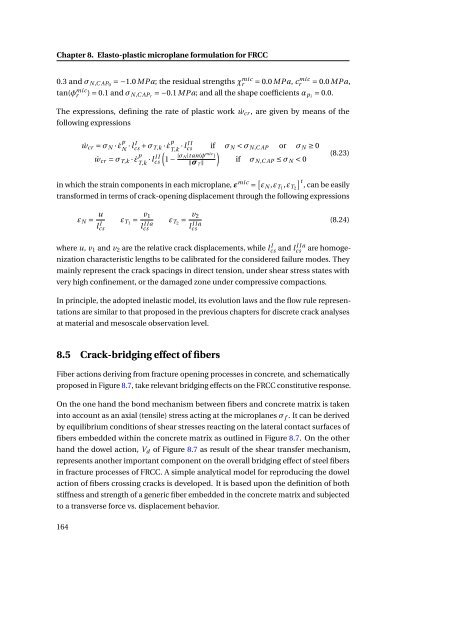tesi A. Caggiano.pdf - EleA@UniSA - Università degli Studi di Salerno
tesi A. Caggiano.pdf - EleA@UniSA - Università degli Studi di Salerno
tesi A. Caggiano.pdf - EleA@UniSA - Università degli Studi di Salerno
- No tags were found...
Create successful ePaper yourself
Turn your PDF publications into a flip-book with our unique Google optimized e-Paper software.
Chapter 8. Elasto-plastic microplane formulation for FRCC0.3 and σ N ,C AP0 = −1.0 MPa; the residual strengths χ mi cr= 0.0 MPa, c mi cr= 0.0 MPa,tan(φ mi cr ) = 0.1 and σ N ,C APr = −0.1 MPa; and all the shape coefficients α pi = 0.0.The expressions, defining the rate of plastic work ẇ cr , are given by means of thefollowing expressionsẇ cr = σ N · ˙ε p N · l cs I + σ T,k · ˙ε p T,k · l cs I I if σ N < σ N ,C AP or σ N ≥ 0()ẇ cr = σ T,k · ˙ε p T,k · l csI I 1 − |σ N |t an(φ mi c )‖σ T ‖if σ N ,C AP ≤ σ N < 0(8.23)in which the strain components in each microplane, ε mi c = [ ε N ,ε T1 ,ε T2] t , can be easilytransformed in terms of crack-opening <strong>di</strong>splacement through the following expressionsε N = ul I csε T1 = v 1l I I acsε T2 = v 2l I I acs(8.24)where u, v 1 and v 2 are the relative crack <strong>di</strong>splacements, while lcs I and l csI I a are homogenizationcharacteristic lengths to be calibrated for the considered failure modes. Theymainly represent the crack spacings in <strong>di</strong>rect tension, under shear stress states withvery high confinement, or the damaged zone under compressive compactions.In principle, the adopted inelastic model, its evolution laws and the flow rule representationsare similar to that proposed in the previous chapters for <strong>di</strong>screte crack analysesat material and mesoscale observation level.8.5 Crack-bridging effect of fibersFiber actions deriving from fracture opening processes in concrete, and schematicallyproposed in Figure 8.7, take relevant bridging effects on the FRCC constitutive response.On the one hand the bond mechanism between fibers and concrete matrix is takeninto account as an axial (tensile) stress acting at the microplanes σ f . It can be derivedby equilibrium con<strong>di</strong>tions of shear stresses reacting on the lateral contact surfaces offibers embedded within the concrete matrix as outlined in Figure 8.7. On the otherhand the dowel action, V d of Figure 8.7 as result of the shear transfer mechanism,represents another important component on the overall bridging effect of steel fibersin fracture processes of FRCC. A simple analytical model for reproducing the dowelaction of fibers crossing cracks is developed. It is based upon the definition of bothstiffness and strength of a generic fiber embedded in the concrete matrix and subjectedto a transverse force vs. <strong>di</strong>splacement behavior.164
















